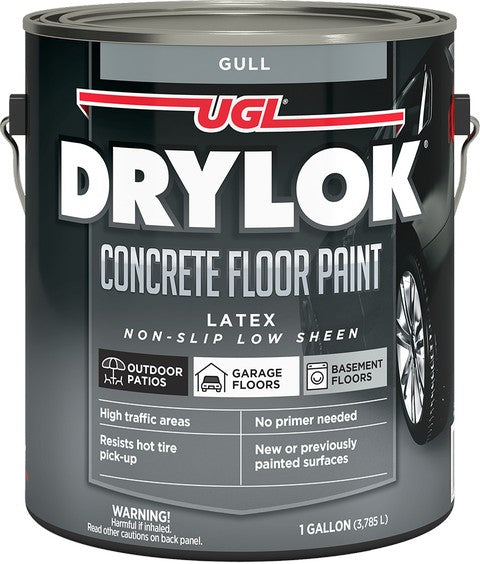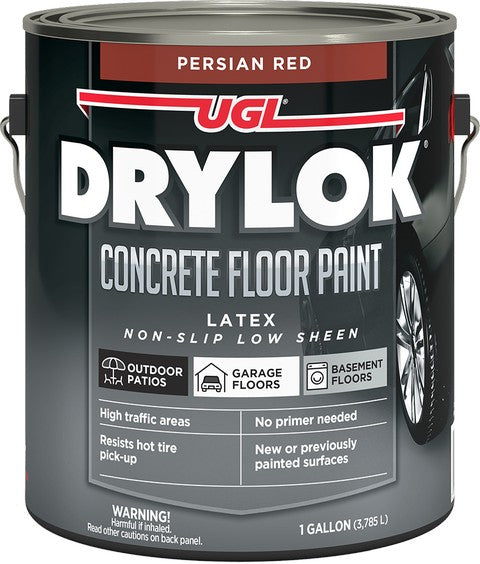DRY TIME:
To touch: 30 minutes-1 hour
To recoat: 4 hours
Light use: 4 hours
Heavy use: 24 hours
Vehicular traffic: 5 days
Note: Maximum cure and dry time will be prolonged when slightly humid and/or damp, cool conditions prevail.
CLEAN UP: Soap and water Dispose of contaminated absorbent, container and unused contents in accordance with local, state and federal regulations.
COVERAGE (SQ. FT./US GAL.): 500-600 sq. ft./gal. Note: Actual coverage will vary depending upon application method, surface texture and porosity.
RECOMMENDED FILM THICKNESS/COAT: 4 wet mils/coat
FLASH POINT: N/A
SHELF LIFE: 5 Years
FREEZE/THAW: 100 VOC - Stable 50 VOC - Keep from freezing
VOC DRYLOK Concrete Floor Paint- Does not exceed 50 g/L
The success of your project is dependent upon the degree of surface preparation provided. Surface must be clean and free from dirt, dust, grease, oil, soap, wax, concrete curing membranes and the oily film left by sweeping compounds. Stains on the surface should be removed using UGL DRYLOK Concrete Cleaner & Degreaser or a heavy duty detergent until the surface is clean. Rinse thoroughly with clean water and allow to dry completely. If using a pressure washer, do not use on a pressure setting above 1750 psi to avoid damaging the concrete. Remember concrete acts like a “stone sponge.” Pressure washing and cleaning in general may trap residual moisture in the concrete. To check for trapped moisture, tape a 12” x 12” piece of 3 mil plastic or aluminum foil tightly on all four edges to the surface. Remove it after 24 hours. If the floor side of the plastic or foil is damp allow additional drying and then repeat the test. A dehumidifier or fan may help to eliminate residual trapped moisture. The concrete to be painted should have a slight texture, such as the look and feel of 150 grit sandpaper or a broom finish. A clean, thoroughly dry, broom finished surface is ready to paint. Highly troweled or extremely smooth concrete must be acid etched (see below) or mechanically abraded for proper Concrete Floor Paint adhesion. Interior Concrete, Previously Painted Surfaces or Wood: Surfaces must be thoroughly clean. Remove loose or flaking paint by wire brushing or scraping. Glossy previously painted surfaces must be dulled
with sandpaper. For highly troweled or extremely smooth bare concrete, refer to “ACID ETCHING INSTRUCTIONS”. Acid Etching: Acid etching will dissolve certain minerals in the top layer of concrete, creating a more porous surface for improved penetration. To etch concrete, predampen the entire surface then use DRYLOK Liquid Etch according to label directions until the surface has the look and feel of 150-grit sandpaper. The acid etching process may be repeated until the desired texture is achieved. Test concrete porosity by sprinkling a few drops of water onto the surface in several areas. If the water is readily absorbed, you are ready to paint. If it beads or lays on the surface additional cleaning and etching is needed. Rinse thoroughly with clean water and allow to dry for 24 hours. NOTE: Rinse etching solutions thoroughly. Etching solution allowed to dry on the masonry surface will prevent proper penetration and curing of the DRYLOK Concrete Floor Paint . Surface must be thoroughly dry. Do not apply to damp surfaces. For exterior surfaces, do not apply if rain is expected within 24 hours. Wait for a dry, rain-free period. All residual acid must be removed from the surface, rinse thoroughly and allow to dry, (see “Check for Trapped Moisture” above) prior to application of the DRYLOK Concrete Floor Paint. On areas that have had efflorescence (salt-like deposit) problems or exposure to excess levels of salt compounds, it is recommended that DRYLOK Concrete Protector, be applied according to label directions prior to application of the DRYLOK Concrete Floor Paint. Garage Floors and Exterior Concrete Surfaces: Surface must be thoroughly clean and all previous coatings must be removed. Apply to bare concrete. Freshly poured concrete and new concrete must cure 30 days prior to painting. For surfaces subject to HEAVY use, highly troweled or extremely smooth concrete, refer to “ACID ETCHING INSTRUCTIONS”. Stir thoroughly before and during application. Air and surface temperatures must be above 50°F during application and remain there for 4 hours after application for proper film formation to occur. Thin the first coat with one pint of water per gallon of paint and apply by brush (a good quality nylon/polyester blend) to ensure good adhesion. Allow to dry 4 hours. Apply a second coat full strength by brush or 1/4” nap roller.
If you scrape, sand, or remove old paint, you may release lead dust. LEAD IS TOXIC. EXPOSURE TO LEAD DUST CAN CAUSE SERIOUS ILLNESS, SUCH AS BRAIN DAMAGE, ESPECIALLY IN CHILDREN. PREGNANT WOMEN SHOULD ALSO AVOID EXPOSURE. Wear a NIOSH- approved respirator to control lead exposure. Clean up carefully with a HEPA vacuum and a wet mop. Before you start, find out how to protect yourself and your family by contacting the National Lead Information Hotline at 1-800-424-LEAD or log on to www.epa.gov/lead.
Stir thoroughly before and during application. Air and surface temperatures must be above 50°F during application and remain there for 4 hours after application for proper film formation to occur. Interior Concrete, Previously Painted Surfaces or Wood: Apply first coat by brush (a good quality nylon/polyester blend) or 1/4” nap roller. For unpainted surfaces, first coat should be thinned with one pint of water. For previously painted surfaces in good condition, apply full strength. Allow 4 hours drying time and apply a second coat. Garage Floors and Exterior Concrete Surfaces: Thin the first coat with one pint of water per gallon of paint and apply by brush (a good quality nylon/polyester blend) to ensure good adhesion. Allow to dry 4 hours. Apply a second coat full strength by brush or 1/4” nap roller.
Floors that are subjected to hydrostatic pressure (water seeping from underneath the floor) or are continually damp cannot be satisfactorily painted with any paint or coating. Moisture on basement floor caused by water seeping through masonry walls or through floor-wall joints or cracks must first be eliminated. Use DRYLOK Fast Plug, a quick setting hydraulic cement, to fill floor- wall joints or cracks, and DRYLOK Masonry Waterproofer to seal masonry walls.In addition, outside work may be required to eliminate water infiltration.
Avoid prolonged contact with skin or breathing of spray mist.
















